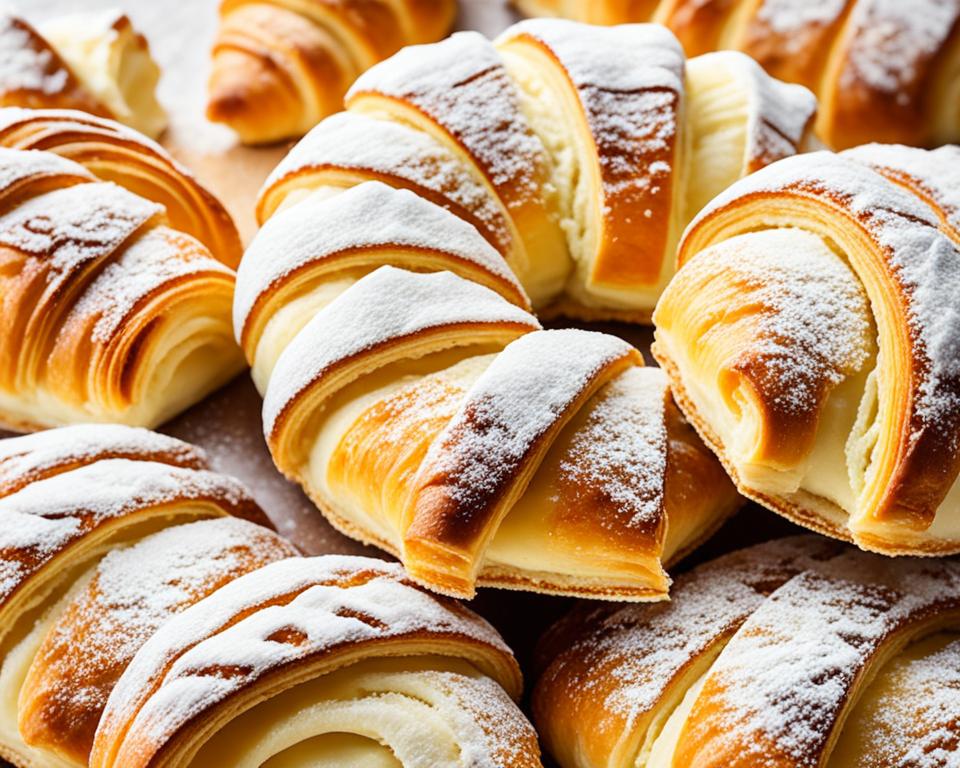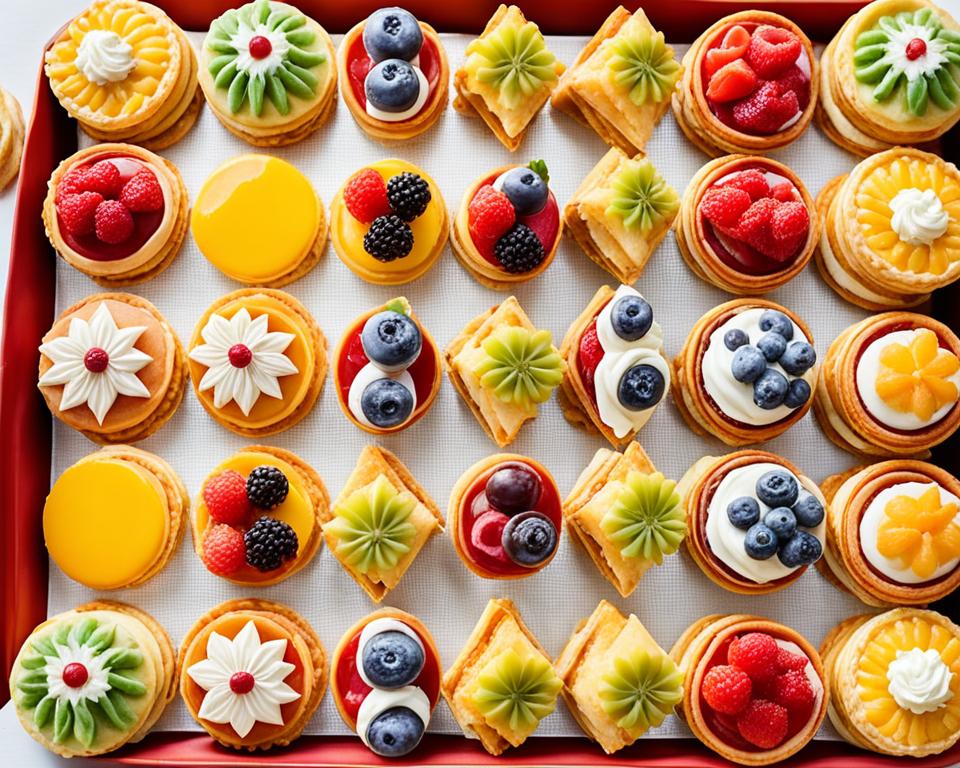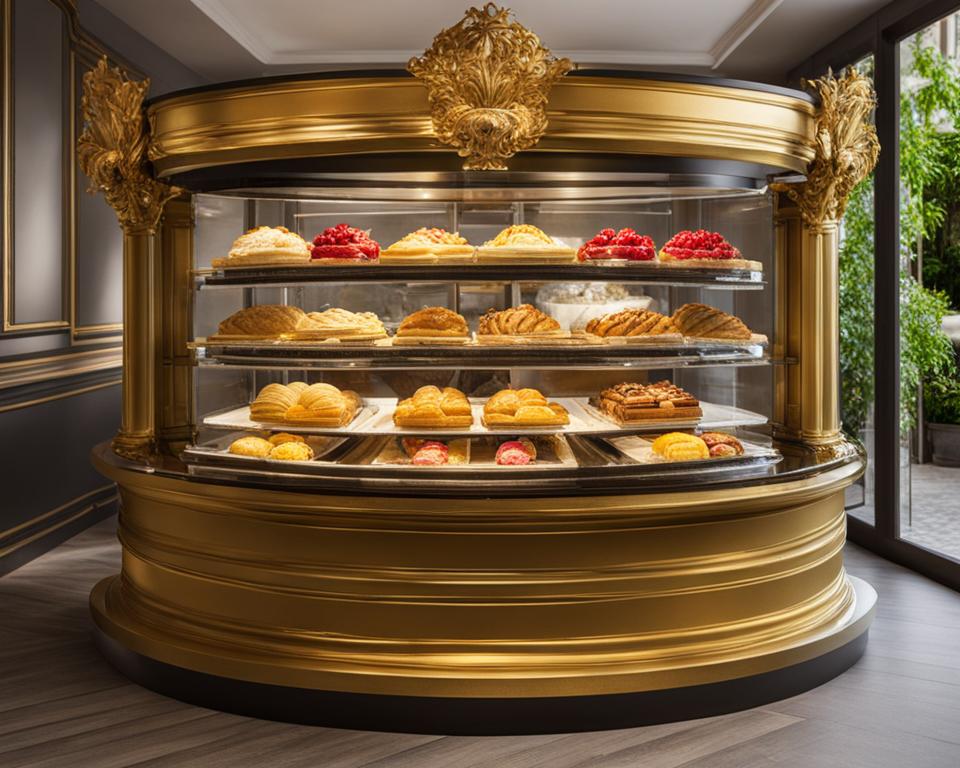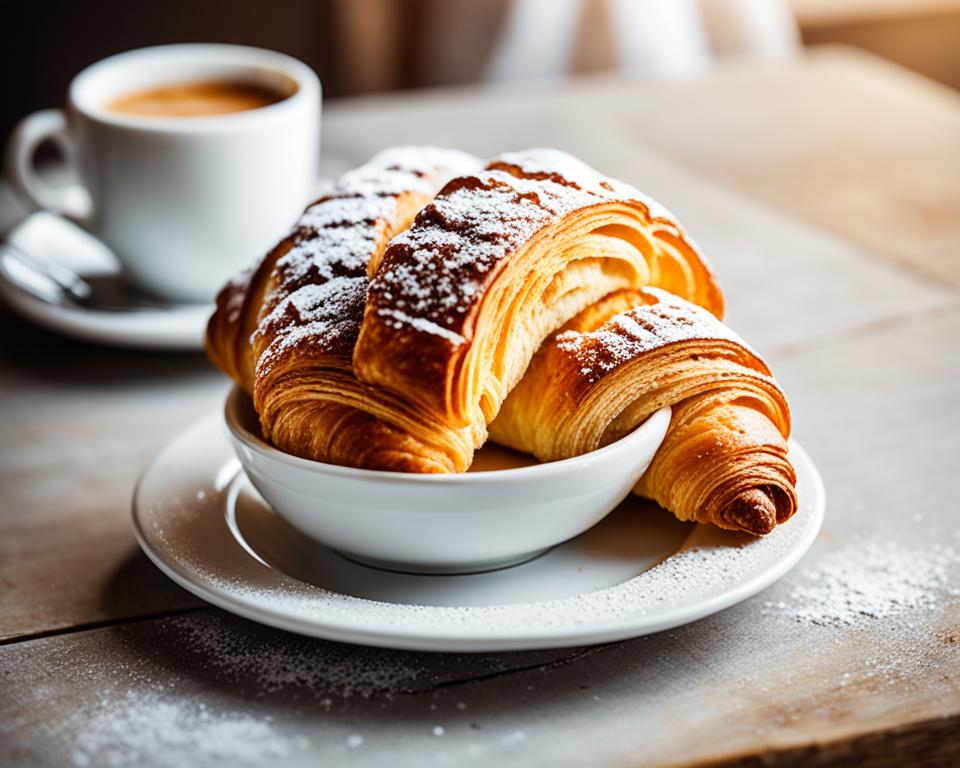When it comes to the artistry of baking, nothing quite captures the essence of decadence like a perfectly crafted fluffy pastry. This delightful baked wonder, known for its airy and crisp layers, triumphs in texture and taste. At the core of its creation is a generous use of high-quality butter, meticulously worked into the pastry dough to yield a product that’s not just a treat for the palate but a spectacle for the eyes. Whether showcased in elegant croissants or sumptuous flaky pastries, fluffy pastry remains a testament to the baker’s skill and a cornerstone of culinary indulgence.
While the terms may evoke images of bakers slaving away for hours, modern techniques have simplified the process, making it accessible even for the casual home cook. The secret lies in treating the dough with care and precision, allowing each fold and turn to pave the way for the flaky layers to come alive. One’s senses are ignited at the mere thought of these buttery creations emerging hot and golden from the oven, a marvel of simple ingredients transformed into intricate layers of flavor and texture.
The pathway to achieving such a pastry masterpiece begins with understanding the foundational elements and techniques that form the bedrock of this baking classic. Join us as we explore the enchanting world of fluffy pastry, a marvel of gastronomy where the sumptuousness of butter meets the craftsmanship of traditional baking.
Key Takeaways
- Fluffy pastry is renowned for its light and airy texture with multiple crisp layers.
- The key to creating such a pastry is the strategic incorporation of butter into the dough.
- Proper rolling and folding techniques are critical to developing the pastry’s characteristic flakiness.
- Cold butter is essential, as it produces steam during baking that puffs up the pastry into flaky layers.
- With careful technique, home bakers can produce pastries reminiscent of those from professional bakeries.
- The rough puff method has modernized the process, making it more accessible to the average cook.
- Achieving perfect flaky pastry is a balance of skill and patience, but the results are worth the effort.
The Art of Making Fluffy Pastry Dough
The creation of homemade pastry, with its beautifully aerated flaky layers, is nothing short of an art form. The exquisite ballet of pastry techniques begins with a meticulous process: the careful incorporation of butter into the dry base. To achieve the delightful crispness that characterizes puff pastry dough, the butter must be maintained in large, cold chunks, and the dough must be repeatedly rolled and folded. This sequence not only forges the multiple layers but also ensures each bite captures the quintessence of what pastry connoisseurs celebrate about a homemade creation.
Shying away from the complexity of traditional methods, the ‘rough puff’ technique is cherished for its simplicity and expedience. This approach has secured a place in the hearts of both seasoned professionals and novice bakers alike. Unlike yeast-leavened breakfast pastries or the intricacies of classic butter-laminated doughs, the rough puff does not require the delicate balance of a leavening agent or exhaustive chilling periods between folds.
As the dough is worked on by practiced hands, large buttery veins remain nestled within its body, ready to melt, steam, and expand in the oven’s heat. With each meticulous fold—a forward roll, a business-like letter turn, a press to seal—the dough transforms. What begins as a simple mixture of staple ingredients evolves into an exquisite architectural feat of countless delicate layers, a marvel that stands at the zenith of pastry recipes.
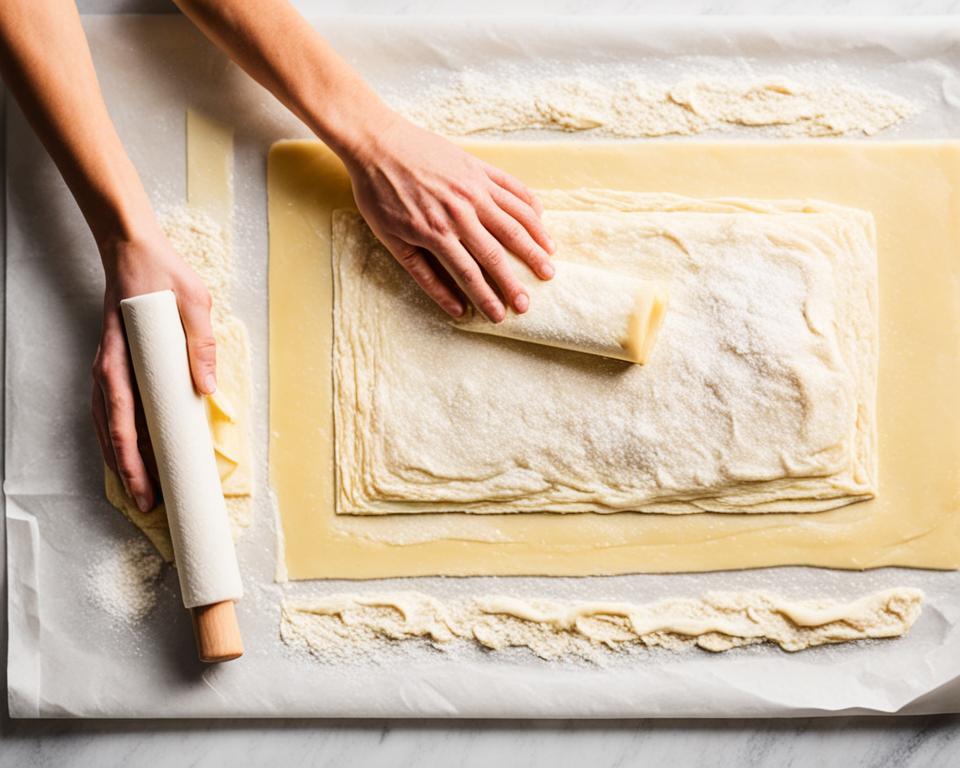
With the understanding that precision dictates the success of every fluffy pastry, consider the rough puff method not just a series of steps but an embodiment of the baker’s aspiration for excellence. The layers, numbered yet seemingly infinite, tell a story of patience and precision where the reward is as tangible as it is delectable. True, it may be an intermediary level of challenge for the home baker, but the results far exceed the expectation—ushering forth puff pastries that rival the delicacies of fine patisseries.
For those willing to embark on this journey, here is a brief overview of the key stages that frame the essence of making a perfect homemade puff pastry:
- The initial mix: a dry blend of flour and salt with cubed cold butter loosely worked in, leaving visible chunks.
- Hydration: sparse drops of ice water introduced gently to bind, avoiding over-mixing, resulting in a shaggy but cohesive mass.
- The rolling marathon: systematic, measured rolling out and folding, akin to crafting a tender, edible fabric.
- The cool resting phases: essential chilling times that entrench the butter’s form and the gluten’s relaxation, setting the stage for puffing magnificence.
Every aspiring pastry artist embarking on this journey will find that through the use of pastry techniques heralded by tradition but revised for the modern-day, creating homemade pastry—be it for an elaborate gastronomic centerpiece or a humble family dessert—becomes not just manageable but profoundly satisfying. Thus, the rough puff method emerges as an invaluable approach, one that promises to elevate the landscape of pastry recipes with every fold, roll, and turn.
Key Ingredients for the Perfect Fluffy Pastry
To craft a top-tier fluffy pastry, certain ingredients are indispensable. Each plays a pivotal role in the final pastry’s texture, rise, and flavor. Famed for its delicate layers and rich taste, a successful pastry dough calls for meticulous selection and handling of these components.
Importance of Cold Ingredients
In pastry-making, temperature control is not merely important—it’s crucial. The use of cold ingredients ensures that the butter maintains its shape throughout the folding and shaping stages. When heat is finally applied during baking, the cold butter rapidly melts, creating pockets of steam that lift the pastry into numerous, airy layers. The ideal outcome is a high-rise puff pastry, marked by its arresting flakiness that pastry recipes strive to achieve.
| Ingredient | Role in Pastry | Optimal Temperature |
|---|---|---|
| Butter | Forms layers; Provides flavor | Cold |
| Water | Binds dough; Creates steam | Ice-cold |
| Flour | Provides structure | Room Temp or Chilled |
| Sugar and Salt | Enhances flavor; Regulates fermentation | Room Temp |
Butter’s Role in Flakiness
The conduit to quintessential flakiness in pastry types such as puff pastry and croissants is butter. High in fat, butter imparts tenderness and flavor while serving as the lamination agent between dough layers. When cold butter is correctly incorporated into the dough and later heats in the oven, the magic of puffing happens, elevating pastry recipes to their iconic status among baked goods.
The Rough Puff Method Explained
The ‘rough puff’ method offers a gateway to homemade pastry recipes without the rigor of classical techniques. It simplifies the pastry-making process by eliminating the need for strict butter lamination and extensive chilling times. Instead, large, cold pieces of butter are gently mixed into the dry ingredients, mirroring a process similar to making pie crust, but with an outcome that distinctly mimics traditional pastry techniques.
In summary, the foundation of an impeccable fluffy pastry lies within its ingredients and their preparation. Mastery of temperature and understanding butter’s integral role in creating flaky textures will guide bakers towards the desired golden layers of puff pastry. Embrace the rough puff method as your trusted companion, and unlock a world where pastry recipes are not just made but crafted to perfection.
Techniques to Achieve the Ultimate Flaky Texture
Mastering the techniques for making perfect puff pastry is essential for any baker looking to create the most flaky, buttery delights. From delightful pastry recipes for savory quiches to sweet tarts, understanding these methods is key to achieving that sought-after light and layered texture inherent to homemade pastry. Below we delve into the steps and subtleties that ensure pastry excellence.
Rolling and Folding: Step-by-Step
To begin, the dough is made from a shaggy clump. On a lightly floured surface, it is rolled out into a rectangle. At this stage, even thickness across the dough is crucial for uniform layers in your pastry. It’s a delicate balance: enough manipulation to create layers, but not so much as to cause the dough to lose its tender, airy quality. The dough is then meticulously folded like a business letter, turned, and rolled out again. This technique is repeated, each stage building upon the previous to compound the layers and contribute to the ultimate flaky texture.
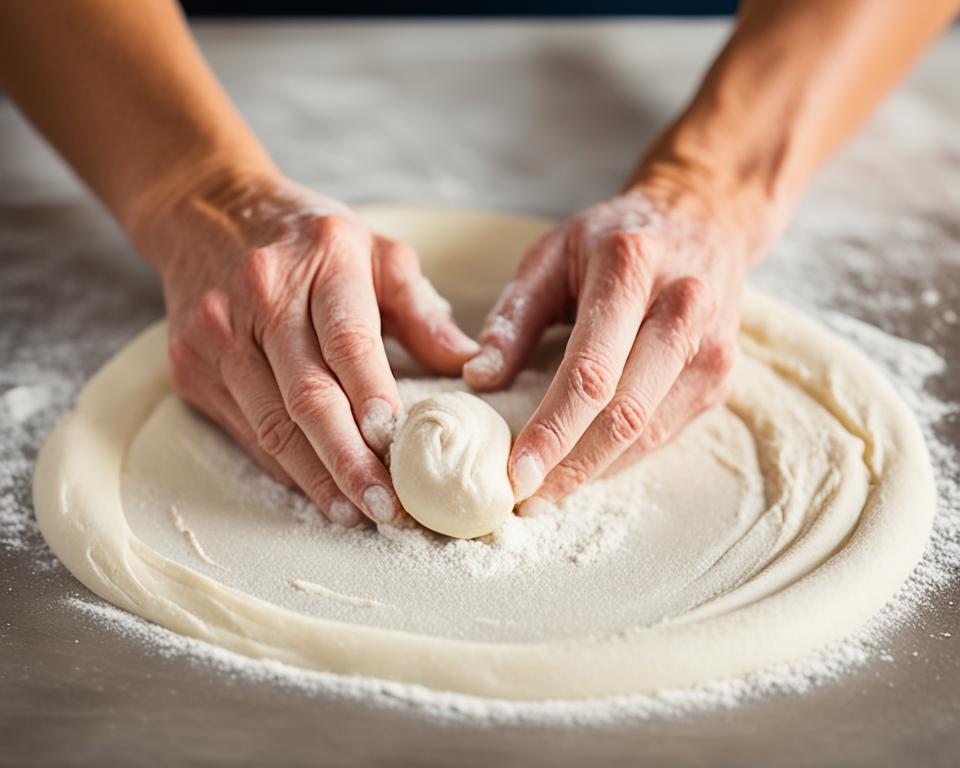
Why Resting and Chilling is Essential
Once the initial pastry techniques of rolling and folding are completed, resting and chilling become pivotal. Placing the dough in the refrigerator allows the gluten strands to relax, maintaining the structure without becoming elastic. Chilling also keeps the butter firm, preventing it from melding into the dough too soon—a necessity for creating steam and lift within each layer during baking. Through both rest and chill, the dough achieves the right condition to puff perfectly in the oven, a staple goal in homemade pastry recipes.
Common Mistakes to Avoid in Pastry Making
Awareness of common pastry mistakes is just as critical as knowing the correct methods. Overworking the dough is a frequent error that can lead to a loss of distinct layers, resulting in a tougher pastry. When rolling out the dough, caution must be taken to prevent the butter from warming and softening too much. Additionally, using a food processor or pastry blender can be too aggressive, breaking down the butter too much and compromising flakiness. Expert bakers recommend hydrating the dough evenly but sparingly—too much water results in a sticky dough, while too little prevents proper lamination.
The culmination of these steps, when executed with precision, leads to the creation of divine puff pastry that boasts the cherished flaky layers, ideal for all pastry recipes.
Conclusion
Within the realms of baking, the pursuit to comprehend what is fluffy pastry has led us down a path where precision and finesse take center stage. Be it through the myriad of pastry recipes or the varied pastry techniques shared amongst expert bakers and culinary enthusiasts, the fluffy pastry stands as a testament to their dedication to craft. The allure of puff pastry — its light, billowy layers and rich, buttered undertones — is undeniable, and its execution a badge of honor for those who master it.
Key to the mastery of making fluffy pastry is the preservation of the integrity of butter, keeping it chilled and discrete within the pastry matrix. The rolling and folding must be as intentional as it is delicate, ensuring that the final product presents itself in stratified splendor. The specifics of chilling times cannot be overlooked, setting the scene for success as the layers become ever more defined and ready for their ultimate transformation in the oven.
The symphony of flavors and textures that come forth in each finished flaky creation makes the journey of learning these techniques invaluable. While practice is the truest companion to perfection, the reward of a home-baked, crispy-layered pastry is a savory and sweet triumph in any kitchen. In closing, the union of skillful technique, careful ingredient handling, and tempered baking culminates in the zenith of fluffy pastry, an illustrious feature of the baking world that continues to captivate and impress.
FAQ
What exactly is fluffy pastry?
Fluffy pastry is a type of pastry dough known for its light and airy texture due to its numerous, crisp layers. It’s made with a high-fat content, usually butter, and is distinctive for its flaky, buttery finish seen in croissants and puff pastries.
Can you explain the art of making fluffy pastry dough?
Making fluffy pastry dough, particularly puff pastry, involves delicately incorporating chunks of butter into the dry ingredients followed by a series of rolling and folding. This technique creates a multitude of flaky layers as the butter creates steam while baking, puffing up the layers within the dough.
What are the key ingredients for making perfect fluffy pastry?
The key ingredients for making a perfect fluffy pastry include cold butter, which is crucial, along with flour, sugar, salt, and cold water. These ingredients are combined to create a dough where the butter essentially separates the dough into delicate, thin layers during baking.
Why is using cold ingredients so important in making fluffy pastry?
Cold ingredients, particularly butter, are essential in preventing the fat from melting during the rolling and shaping process. This ensures that, when baked, the solid butter chunks melt to create steam and puff up the dough, resulting in the signature flakiness of the pastry.
How does butter contribute to a pastry’s flakiness?
Butter’s fat is the main contributor to a pastry’s flakiness. When kept cold and worked properly into the dough, it creates distinct layers. As it melts during baking, it releases steam that separates these layers, forming a crisp and tender texture.
What is the rough puff method?
The rough puff or quick pastry method is a technique where large pieces of cold butter are incorporated into the dry ingredients, hydrated with ice-cold water, and the dough is rolled and folded several times to create layers. This method is easier and quicker than traditional butter lamination and produces a similarly flaky pastry.
What techniques are employed to achieve the ultimate flaky texture in pastry?
Key techniques for achieving flaky texture in pastry involve careful rolling and folding to maintain layers of fat and dough, proper resting and chilling during the process to keep butter firm, and avoiding overworking the dough which can diminish flakiness.
How do you roll and fold pastry dough step-by-step?
After combining the ingredients into a dough, roll it out on a floured surface to a rectangle and fold it in thirds like a letter. This process is repeated multiple times, turning the dough each time to ensure even rolling. This creates the layers that lead to flakiness.
Why is resting and chilling the pastry dough essential?
Resting and chilling the dough allows the gluten strands to relax and prevents the butter from melting before baking. It also helps set the layers of fat and dough, ensuring maximum rise and flakiness after the dough has been rolled and folded.
What are some common mistakes to avoid when making pastry?
Common mistakes in pastry making include overworking the dough, not keeping the butter chilled, and using food processors or pastry cutters too aggressively. It’s also crucial to hydrate the dough evenly without making it sticky to achieve the desired texture.

